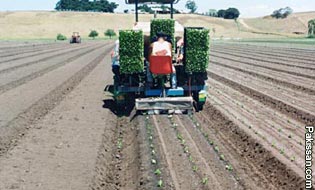|
Managing salinity for
sustainable agricultural development
By Muhammad Saleem & Sarfraz Hussain
ABOUT 60 per cent of tubewell water used for irrigation in
Pakistan is saline to sodic in nature that adds salt in
agricultural lands each year. The overall aquifer, with a
potential of about 50 MAF, is being exploited to an extent of
about 38 MAF by over 562,000 private tube-wells and about
10,000 public. On an average, this water contains 1,250mg of
soluble salts per litre of irrigation water.
 The
poor quality of water has adversely impacted the land
resources of irrigated area. About three million hectare of
agricultural land is severely affected since the adaptation of
tube-well water for irrigation during SCARPs project for land
reclamation. The over-use of groundwater has encouraged
intensive farming in rural areas but is being over-exploited. The
poor quality of water has adversely impacted the land
resources of irrigated area. About three million hectare of
agricultural land is severely affected since the adaptation of
tube-well water for irrigation during SCARPs project for land
reclamation. The over-use of groundwater has encouraged
intensive farming in rural areas but is being over-exploited.
Due to the lack of management, a number of socio-economic
problems in terms of farmerís limitations in its continuous
uses due to salinity hazards have cropped up. Salinity leads
to dispersion of fine soil particles, crust formation, and a
decrease in water movement within soil profile. The amount of
sodium accumulated onto the soil particles and in irrigation
water greatly influences crop production potential of the
cultivated lands.
Most of the groundwater resources are confined to the Indus
Plain, extending from the Himalayan foothills to Arabian Sea.
The plain is about 1,600km long and covers an area of 21Mha
and is blessed with extensive unconfined aquifer which is fast
depleting and deteriorating due to over-exploitation and
continued dry spell years.
The unchecked installation of tube-wells with little know-how
among farming communities in the selection of extraction depth
has aggravated the pre-existing salinity problem in these
areas. Apparently farmers have no technical assistance to go
through this worsening situation. In several areas like some
parts of Faisalabad, Hafizabad, Okara, Kasur and many other
districts of both Punjab and Sindh provinces, the upward
groundwater is extremely saline to saline-sodic in nature.
At the turn of the 20th century large water reservoirs were
built and a network of canals turned the plains of north
Pakistan green. Later on, silently the irrigation system began
to blight the land it had brought to life. Seepage from the
network of unlined channels raised the water-table, while
washing the salts from the soil into water. At the surface,
sunlight and wind evaporated the water and left the salt on
surface soils. This endangered withered plants and killed soil
organisms creating dead and barren wasteland and mild to
severe desertification.
Not only in Pakistan but from Morocco to China and to
Australia, this phenomenon has affected soil environment.
According to the FAO, about 77 million hectares of
agricultural land, an area twice as big as Germany, has been
devastated by salt and salty/brackish waters.
In Pakistan 16 million hectares of agriculture area is fed by
a network of canals and tube-wells and 26 per cent has become
moderate to severe salt-affected by this secondary or
irrigation salinity phenomena. But on the other side in many
parts of irrigated zone where groundwater is sweat and fit for
irrigation, other factors like intensive farming, lack of
canal water and fragmentation of farm land have accelerated
over-exploitation of aquifer.
It has been observed in some parts that each landholder of
only three hectares has his own tube-well. This mobilizes the
groundwater flow beneath the soil surface in the aquifer, thus
polluting it significantly.
In many areas, the naturally developed partitioning beneath
the soil surface between fresh and brackish water is
diminishing and pollution of fresh water aquifer is on the
increase. This underground flood of brackish water toward
fresh waters has also gained momentum due of the lack of
natural recharge carried out by the rainfall.
Natural imbalance in terms of fewer rainfalls coupled with
global warming and futile recharge of aquifer and
mismanagement in the use of natural resources may lead to
sever desertification of our land resources. The subsequent
and overlapping factors may affect the productivity of our
agricultural sector and the economy. To overcome this most
undesirable socio-environmental dilemma following steps are
suggested.
* Over installation of tube-wells should be discouraged
through effective campaigns.
* Provision of necessary technical assistance to farming
communities should be available to guide them at what depth
they should extract the ground to extract fresh water instead
of saline water.
* In severally affected areas bio-saline agriculture should be
promoted to mitigate ill-effects of salinity hazardous.
* Conservation strategies should be put into practice to make
the optimum use of available fresh water.
* Cropping pattern should be fairly modified to produce those
crops in sensitive areas which are water and salinity
resistant.
dawn |
Pakissan.com;
|